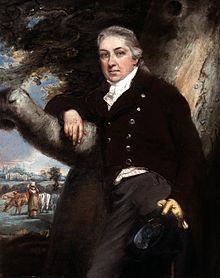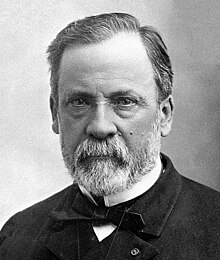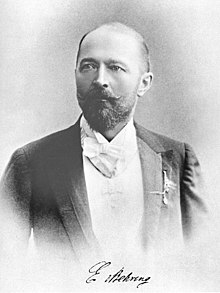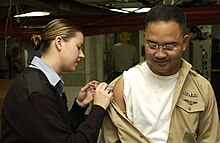immunology
The immunology and immunobiology is the study of the biological and biochemical basis of physical defense against pathogens such as bacteria , viruses and fungi and other foreign substances such as biological toxins and environmental poisons, and beyond faults and malfunctions of these defense mechanisms. It is therefore a sub-discipline of biology . The subject of research is the immune system , a system of cellular and molecular processes that realize the recognition and inactivation of pathogens and foreign substances. These processes are under the termImmune response summarized. Due to the central role of the human immune system in a large number of diseases, immunology is of great importance in medicine for the understanding, prevention , diagnosis and therapy of diseases.
There are different branches of immunology. The immunochemistry to investigate the structure of antigens , antibodies and chemical bases of immune responses. The immunogenetics investigated the genetic variability of immune responses and the mechanisms of production of antibodies, T cell receptors and antigen presenting complexes. The immunopathology and clinical immunology investigate immune system disorders, for example, in the case of allergies , in the formation of tumors and autoimmune diseases occur.
history
Early observations
The oldest known records that contain evidence of immunologically relevant phenomena date from the year 430 BC. The historian Thucydides stated during the so-called Attic plague in Athens at the time of the Peloponnesian War that only people who had already endured and survived the disease were eligible for the care of the sick. The first reports from China of a targeted transmission of smallpox to healthy people for the purpose of prevention are known from around the year 100 BC . This procedure, in which pus was transferred from slightly ill people to healthy people with a needle, became widespread under the name " Variolation " since the 15th century, especially in China, India and Turkey. Through Mary Wortley Montagu , the wife of the British ambassador in Constantinople, who had her son vaccinated in this way, the variolation came to England from around 1722 and spread to the rest of Europe in the following years.
At the same time, the English country doctor Edward Jenner learned from doctors with whom he was in contact that people did not seem to respond to smallpox variolation if they had previously had cowpox . After intensive observation of this phenomenon, on May 14, 1796, he inoculated the healthy eight-year-old boy James Phipps with tissue fluid that he had taken from a pustule from a milkmaid infected with cowpox. After the boy had survived the mild course of the cowpox, Jenner subjected him to a real smallpox variolation. He did not develop any symptoms of smallpox, and he also proved immune to repeated variations and outbreaks of smallpox. In comparison to Variolation, Jenner's method ("vaccination") offered some decisive advantages: The people vaccinated with cowpox did not have the pustules and the resulting scars that are typical for smallpox, there was no fatal course of the vaccination and the vaccinated people themselves did not pose any risk of infection that is why Edward Jenner is considered the founder of immunology today.
Start of immunological research
A milestone in the development of immunology that marked the beginning of targeted research was the development of a vaccine against rabies in 1885 by Louis Pasteur . On July 6, 1885, he used it to vaccinate nine-year-old Joseph Meister, who had been bitten by a rabid dog two days earlier. Joseph Meister became the first person in the history of medicine to survive a rabies infection. Within a year, this vaccination was used in 350 other infected people, none of whom died of rabies. Robert Koch discovered the causative agent of tuberculosis three years earlier and a short time later discovered the tuberculin reaction, which enabled the detection of a tuberculosis infection on the basis of the immune response.
1888 discovered Pierre Paul Émile Roux and Alexandre Yersin the diphtheria toxin. Two years later, Emil Adolf von Behring and Shibasaburo Kitasato were able to detect so-called antitoxins in the serum of patients who had survived diphtheria. Emil Adolf von Behring also began using these antisera to treat diphtheria. He received the Nobel Prize in Physiology or Medicine, first awarded in 1901, for his research results . The Belgian bacteriologist Jules Baptiste Vincent Bordet discovered in 1898 that heating the serum to 55 degrees Celsius had little effect on the ability of the serum to bind to certain chemical substances, but the serum's bactericidal effect was lost. On the basis of this discovery, he postulated the existence of a heat-sensitive component in the serum, which was necessary for the effect of the serum on bacteria, and named this component "Alexin". In the years that followed, Paul Ehrlich investigated this component and introduced the term “complement”, which is still used today.
Two schools of thought emerge
At the beginning of the 20th century, immunological research was divided into two approaches. The humoral immunologists, the most prominent of them Paul Ehrlich and Emil Adolf von Behring, took the view that the foundations of defense against infection are to be found in substances in blood serum, i.e. the antitoxins. This theory was the predominant view around 1900 and in the following decades. In addition, the view of cellular immunologists developed, based in particular on the work of George Nuttall and Ilja Iljitsch Metschnikow from around 1883/1884. Metschnikow was able to demonstrate the importance of the body's own cellular processes for the defense against pathogens on the basis of studies on the effect of white blood cells on bacteria. As it turned out later, both aspects are equally involved in the functioning of the immune system and in the immune response. It was not until around 1940, however, that the views of cellular immunologists gained general acceptance and the assumption that antibodies were the main mechanism of immune defense was abandoned.
In 1901, Karl Landsteiner discovered the AB0 blood group system and thus made another important contribution to understanding the immune system. Clemens Peter Freiherr von Pirquet found in 1906 that patients reacted violently to the second treatment after repeated administration of horse serum. He coined the term “ allergy ” for this hypersensitivity reaction . Emil von Dungern and Ludwik Hirszfeld published their results on the inheritance of blood groups in 1910 and thus for the first time results on the genetics of components of the immune system. In this work, the two of them also suggested the designation "AB0" as a new nomenclature - but it was only introduced in 1928 as an internationally binding one. In 1917 Karl Landsteiner first described the concept of haptens , small molecules which, when coupled to a protein, can trigger an immune reaction with the formation of specific antibodies. In 1926, Lloyd Felton succeeded in purifying antibodies from serum. In the 1930s, Michael Heidelberger was able to show that antibodies are proteins in terms of their chemical nature . In addition, together with Elvin A. Kabat, he was able to prove that antibodies of the gamma fraction correspond to the globulins present in the serum . During the same period, John Marrack first developed a theory for the specific recognition of antigens by antibodies.
Development of modern immunology
In the 1930s, Peter Alfred Gorer discovered the mouse H-2 antigens and thus the first major histocompatibility complex (MHC) in studies with mice for the rejection of transplanted tumors . Peter Medawar and Thomas Gibson were also able to elucidate important functions of immune cells through studies on transplant rejection . This marked the beginning of the final recognition of cellular immunology. In 1948 Astrid Fagraeus found out that antibodies are produced by the B cells in the plasma. A year later, Frank Macfarlane Burnet and Frank Fenner published their hypothesis of immunological tolerance, which was proven a few years later by Jacques Miller with the discovery of the elimination of autoreactive T cell clones in the thymus . In 1957, Frank Macfarlane Burnet described the clone selection theory as the central principle of adaptive immunity.
The Briton Alick Isaacs and the Swiss Jean Lindenmann discovered in 1957 when studying the effects of viral infections on cell cultures that the cells were largely resistant to a second infection by another virus for the duration of one viral infection. They isolated a protein from the infected cell cultures that they called interferon (IFN). At the end of the 1960s and the beginning of the 1970s, John David and Barry Bloom independently discovered the macrophage migration inhibitory factor (MIF) and a number of other substances released by lymphocytes. Dudley Dumonde coined the term "lymphokines" for these substances. Stanley Cohen , who received the Nobel Prize in Physiology or Medicine in 1986 for his discovery of the growth factors NGF and EGF, began studying the functions of the factors known as lymphokines with Takeshi Yoshida in the early 1970s . They discovered that these substances belong to a group of hormone-like messenger substances that are formed by many different cells of the immune system. Stanley Cohen therefore proposed the term " cytokines " in 1974 , which quickly became established with the discovery of more of these substances. In addition to the factors mentioned, over 100 other cytokines are now known and their structure and function have been examined in detail.
The period around 1960 is generally considered to be the beginning of modern immunology. Rodney Porter succeeded between 1959 and 1961 to elucidate the structure of antibodies. At the same time, Jean Dausset discovered the main human histocompatibility complex, the so-called " Human Leukocyte Antigen " complex (HLA complex). From around 1960, a number of scientists also clarified the basics of cellular immunology, which among other things led to the differentiation and description of the B and T lymphocytes and the discovery of their respective functions by Jacques Miller . Thus the division of the immune defense into a humoral and a cellular area prevailed. In the following decades, among other things, the various antibody subtypes were discovered and examined with regard to their function. In 1975, Georges Köhler and César Milstein described the production of monoclonal antibodies . Because of the far-reaching consequences of this discovery for basic research as well as the diagnosis and treatment of diseases, they received the 1984 Nobel Prize in Physiology or Medicine. Other important findings related to the genetic basis of immunology such as the description of the MHC restriction by Rolf Zinkernagel in 1974, the identification of immunoglobulin genes by Susumu Tonegawa in 1985 and of T cell receptor genes by Leroy Hood also from around 1985.
The European Autoimmunity Standardization Initiative has existed since 2002 . In Germany there were only six immunology specialists in Germany in 2019.
Research subject
Central subject of research in immunology is the immune system of mammals . It is a complex system of molecules and cells, through which the recognition and inactivation of foreign structures is realized. The reactions of this system to such structures are summarized under the term immune response . The organs of the body that are responsible for the immune response, together with the lymph vessels, are known as the lymphatic system . The blood circulation is also of crucial importance for the functioning of the immune response .
Research in immunology is primarily concerned with medical and clinical aspects of the immune response, for example its dysregulation in certain diseases as well as its targeted influence in the treatment of diseases. Another important area of research is the application of immunological methods for analytical and diagnostic purposes. Immunology can be subdivided into different sub-disciplines according to the examined sub-aspect, the methodology used and the level of observation.
Cellular immunology
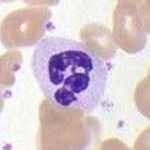
Cellular immunology deals with the cells of the immune system and the reactions they cause. The cells of the innate immune system include, for example, the neutrophil granulocytes , the macrophages also known as scavenger cells , and the natural killer cells (NK cells). At the cellular level, the adaptive immune system comprises the B lymphocytes and the T lymphocytes . In contrast to the innate immune system, the adaptive immune system can develop a specific reaction against certain foreign structures, but only after initial contact. Such an initial contact is not necessary for the innate immune system.
Humoral immunology
Humoral immunology deals with the protein-based processes of the immune system. These include the complement system as part of the innate immune response . In the adaptive part of the immune system, antibodies are responsible for the humoral immune response. Another important research topic in humoral immunology is cytokines . These are proteins that control the regulation of the immune system and the communication between its various components.
Further sub-disciplines
Immunochemistry examines the structure and properties of antigens and antibodies as well as the chemical basis of the immune response. Diagnostic and analytical methods based on the antigen-antibody reaction , such as immunohistochemistry, are an important application of immunochemistry . Immunogenetics deals with the genetic basis of the immune system, for example the genetic variability of immune reactions as well as the mechanisms of the generation of antibodies, T-cell receptors and antigen-presenting complexes . The immunopathology and clinical immunology dedicated to the medical aspects of immunology.
Invertebrate immunology
For historical reasons, immunology mainly deals with the immune system of vertebrates (vertebrates), especially that of mammals . This is mainly due to the medical origins of immunology and has led to the fact that immunology is often presented in textbooks and other publications only with the immune defense in mammals as the subject of research. A sub-area of immunological research is also devoted to the immune system of invertebrates (invertebrates). Compared to the immune system of vertebrates, this is characterized by the lack of an adaptive immune system and thus largely unspecific defense processes, the presence of differentiated biochemical defense mechanisms in the form of antimicrobial factors and pronounced anatomical structures to mechanically prevent the penetration of pathogens and foreign substances. Phagocytic cells play a central role within the cellular immune system of invertebrates.
The aim of this research is on the one hand to better understand the evolution of the immune system and thus also its functions. By comparing the defense mechanisms of different animals, it is possible to see which partial aspects they have in common and how these have developed. One therefore speaks of comparative immunology . Other areas affected by invertebrate immunology research are ecotoxicology , pest control and hygiene . In biomedical research, understanding the immune defense of invertebrates enables them to be used as model organisms in some areas . Individual biochemical components of the invertebrate immune system may also be used for therapeutic and diagnostic purposes.
Pathophysiological Aspects
The immune system is directly or indirectly involved in a wide variety of diseases and other clinically important processes. These can be distinguished on the basis of the underlying mechanisms.
Defense against pathogens
In the case of infections with bacteria, viruses, protozoa or fungi, the immune system normally defends against the penetration and spread of the pathogens. Under certain conditions, however, the immune response can fail or be insufficient, so that an infection spreads and is no longer adequately controlled by the immune system. This can lead to an infection becoming chronic , i.e. the pathogens remain in the body permanently and cause symptoms, either permanently or in bursts. A severe generalized infection , i.e. the spread from a local infection site through the bloodstream throughout the body, is known as sepsis . Due to massive reactions of the body, this is often fatal.
Misdirected or excessive immune response
The so-called autoimmune diseases are based on a misdirected reaction of the immune system against the body's own structures. These reactions can either lead to the irreversible destruction of the body's own tissue or impair the function of the body's own molecules such as receptors and hormones . Autoimmune diseases include type 1 diabetes mellitus , Hashimoto's thyroiditis , myasthenia gravis , Graves' disease and most inflammatory rheumatic diseases, including rheumatoid arthritis .
With allergies , also known as hypersensitivity reactions, there is an excessive reaction of the immune system to certain foreign structures. A prerequisite for the development of an allergy is a harmless initial contact with the foreign substance known as the allergen . This first contact leads to a so-called sensitization, i.e. the development of a specific immune response. Any new contact with the allergen can then lead to an excessively strong reaction of the immune system. Allergies are particularly common to plant pollen , animal hair , food ingredients and medication . Celiac disease is a hybrid form of allergy and autoimmune disease , in which there is a cross-reaction to the gluten protein contained in most types of grain and certain structures in the small intestinal tissue.
Inadequate immune response and immune insufficiency
Among the diseases caused by insufficient immune defenses ( immune insufficiency are presented) include, for example, acquired immune deficiency syndrome AIDS ( Acquired Immunodeficiency Syndrome ) produced by an infection with the HIV virus is triggered. Severe congenital immunodeficiency diseases, in which the humoral and cellular parts of the adaptive immune system are affected at the same time (“combined”), are summarized under the name Severe Combined Immunodeficiency (SCID). Patients with a congenital or acquired immunodeficiency are highly susceptible to infectious diseases which, as the immunodeficiency progresses, usually lead to death.
The immune system also plays an important role in cancer . Patients with an immune deficiency, for example due to immunosuppressive treatment after an organ transplant or an HIV infection, show a significantly increased frequency of certain cancers. The immune system is responsible for controlling degenerate cells so that they are inactivated before a manifest tumor can develop. The sub-area of immunology that deals with the immunological processes involved in the development, course and control of tumors is tumor immunology . The cancer immunotherapy includes a number of immunological therapeutic approaches.
Immune response against grafts and implants
Immunological processes in the transplantation of donor organs are of crucial relevance . Since transplanted organs are recognized by the immune system as foreign, there is a corresponding immune response. If left untreated, this leads to rejection and thus to the loss of function of the organ concerned. Conversely, in the case of a stem cell transplant , for example , immune cells contained in a transplant can also cause an immune reaction against the recipient organism; this is called the graft-versus-host reaction . As a result, lifelong treatment of the affected patients with so-called immunosuppressants , i.e. drugs that suppress short-term and long-term immune reactions, is necessary to preserve the organ .
Similar to the transplantation of foreign organs or tissues, the immune system is also decisively involved in the body's reaction to implants . Implants consist, for example, of metals or plastics and are used for a variety of tasks, including for the temporary or permanent replacement of bones or blood vessels , as plastic implants for shaping certain body structures and for dentures , as well as to replace or support the body's own organs in their function, such as cochlear implants or pacemakers . Since implants are made of exogenous material, they are exposed to a variety of immune defense processes, in particular to a chronic inflammatory reaction . The immunological compatibility of these materials is therefore an important aspect of their biocompatibility and makes a decisive contribution to the long-term function of the implant.
Therapeutic uses
Immune modulation
A number of therapeutic applications that are based on knowledge and principles of immunology can be summarized under the term immunomodulation . This applies to all therapeutic approaches that are based on the targeted influencing of certain processes or components of the immune system.
Widely used, for example, vaccines , which by the administration of antigens the immune system is stimulated to form an immune response against these antigens. Vaccinations play a vital role in the prevention of infectious diseases . In addition, there are initial successes with regard to vaccination against cancer-associated viruses such as the human papilloma virus . The sensitization of the immune system to tumor-specific structures in cancer , known as cancer immunotherapy , is based on the same principle as vaccinations .
Another approach from the field of immune modulation is called desensitization or “specific immunotherapy (SIT)”. The aim is to achieve a so-called immune tolerance of the body to certain antigens. This means that the body's defense reactions against these antigens are reduced. This is to be achieved by repeated administration of the corresponding antigens with a gradual increase in the dose. Desensitization is of therapeutic relevance in allergic diseases. There are also studies on its use in autoimmune diseases.
The term immunosuppression encompasses therapies that aim to suppress unwanted immunological processes. This is made possible by drugs that intervene in various immune defense processes. These drugs are mainly used to prevent the rejection of transplanted organs. Immunosuppressive therapies are also being tested for autoimmune diseases.
An immune stimulation , thus stimulating the immune system and enhance the immune response is also possible. For example, certain endogenous proteins that play a role in regulating the immune system can be used therapeutically. Certain cytokines are most commonly used for this . Appropriate therapies are particularly relevant for virus infections.
Therapeutic Antibodies
Another important application of immunological principles to the treatment of diseases is therapeutic antibodies . These are antibodies, i.e. globulin proteins of the immune system, which are produced biotechnologically and are directed against certain structures in the body. These structures, for which a relevance for certain diseases has been proven beforehand, are blocked or neutralized in their effect by the therapeutic antibodies. These target structures are often proteins on the surface of cells, such as transport proteins, signal proteins or receptors, but also soluble proteins in the serum such as cytokines or hormones. Therapeutic antibodies have now been approved for the treatment of various cancers, autoimmune diseases, allergies and the prevention of transplant rejection.
Antisera
Antibodies are also used as an antiserum against certain toxins . To obtain these antisera, animals such as horses are injected with small amounts of the corresponding poisons. These animals then develop specific antibodies in their blood which neutralize the effects of the toxins. After the corresponding antibodies have been obtained and purified from the blood of these animals, they can be used for the acute treatment of poisoning , for example after snake bites . Antisera obtained accordingly are also used for what is known as passive immunization against certain infectious diseases, if there is insufficient time for active immunization by regular vaccination or if no vaccine is available for active immunization. However, animal antisera induce an immune response by themselves when used repeatedly. For this reason, active immunization is usually preferred when possible. As an emergency measure, passive immunization is carried out if a rabies infection is suspected .
Immunological diagnostics
Immunological laboratory methods play a major role in the diagnosis of diseases and in basic biomedical research . As immunoassays all methods are referred to, the use for the qualitative or quantitative detection of certain structures in liquids the specific recognition of antigens by antibodies. Immunassays are used to identify pathogens as well as to examine body fluids for the presence of certain endogenous proteins that are considered specific biomarkers in diseases . For a number of diseases, in particular allergies, autoimmune diseases and infections, the detection of specific antibodies is possible as part of the diagnosis and for monitoring the progress. Immunassays are also used, for example, as pregnancy tests. Further applications in medicine are the identification of toxins and intoxicating drugs , the monitoring of drugs in the body ( drug monitoring ), or the detection of certain doping substances in sports medicine . In addition to medical diagnostics, immunassays are used, for example, in environmental, food and agricultural analysis, among other things for the detection of environmental toxins, allergens in food or genetically modified organisms .
In organ transplants, bone marrow transfer and blood donations , the molecular genetic characterization of certain histocompatibility markers ensures the greatest possible match between donor and recipient. The immunohistochemistry using antibodies for staining of specific structures in microscopic preparations and is therefore an important application of immunological principles in the pathological diagnosis . In flow cytometry and Magnetic Cell Separation (MACS), antibodies are used to detect certain surface structures on cells and thereby separate cell mixtures or analyze their composition. For clinical diagnostics, for example, this is important in hematology for examining the cell distribution in the blood .
literature
- Lothar Rink, Andrea Kruse, Hajo Haase: Immunology for beginners. Spectrum Akademischer Verlag, Heidelberg 2011, ISBN 978-3-82-742439-6
- Barbara Bröker, Christine Schütt, Bernhard Fleischer: Basic knowledge of immunology. Springer Spectrum, Berlin 2019, ISBN 978-3-662-58329-6
- Charles Janeway , Paul Travers, Mark Walport, Mark Shlomchik: Immunology. 5th edition, Spektrum Akademischer Verlag, Heidelberg 2002, ISBN 3-8274-1079-7 ; Online version , 5th edition, 2001, (English)
- Werner Luttmann, Kai Bratke, Michael Küpper, Daniel Myrtek: The Experimenter: Immunology . 2nd Edition. Spectrum Akademischer Verlag, Heidelberg 2006, ISBN 3-8274-1730-9
- Arnold Hilgers, Inge Hoffmann: Healthy or sick. The immune system decides. Springer, Berlin 1995, ISBN 3-540-59226-1
- Ivan M. Roitt , Jonathan Brostoff, David K. Male: Short Textbook of Immunology. 3. Edition. Thieme, Stuttgart 1995, ISBN 3-13-702103-0
- Abul K. Abbas, Andrew H. Lichtman: Cellular and Molecular Immunology. Saunders (WB) Company, Philadelphia 2005, ISBN 1-4160-2389-5
- David E. Normansell: The Principles and Practice of Diagnostic Immunology. Wiley-VCH, Weinheim 1994, ISBN 1-56081-534-5
- Jules A. Hoffmann, Charles A. Janeway Jr., Shunji Natori: Phylogenetic Perspectives in Immunity, The Insect Host Defense. RG Landes Company, Austin TX 1994, ISBN 1-57059-043-5
- Valerie J. Smith: Invertebrate Immunology: Phylogenetic, Ecotoxicological and Biomedical Implications. In: Comparative Hematology International. 1/1991. Springer London, pp. 61-76, ISSN 0938-7714
Web links
- German Society for Immunology (DGfI)
- Microbiology and Immunology On-line (English)
- NCBI Bookshelf: Immunobiology - The Immune System in Health and Disease (English)
- Introduction to Immunology Video recordings of a lecture. From TIMMS, Tübingen Internet Multimedia Server of the University of Tübingen.
Individual evidence
- ↑ Arthur W. Boylston: The Myth of the Milkmaid . In: New England Journal of Medicine . tape 378 , no. 5 , February 2018, p. 414-415 , doi : 10.1056 / nejmp1715349 .
- ↑ https://www.youtube.com/watch?v=BF6x_gMpXwQ
